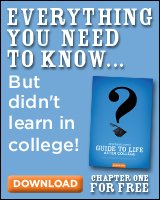30 in 30: The Cover Letter Conundrum

Last week we talked about the importance of tailoring your resume for each position, and we mentioned the importance of customization in each and every step of the application process. Unfortunately, the most important area for customization is also the most annoying: the cover letter. In many cases, writing a good cover letter is harder than actually performing the job that you're applying for. And when you've got to do 40 of them, it can be pretty overwhelming. But here's the deal: while customization is crucial to the art of cover letters, there is a degree to which you can ease the burden if you approach the process tactically.
First and foremost, set up a standard structure for your cover letters (I've included a three-paragraph breakdown below that should work for most people) and download Gradspot's cover letter template. While each cover letter will involve a heavy degree of tampering, you can do some recycling if you have a standard structure. Cover letters should display your personality and ability to communicate well in writing, but great works of art they are not—stick to a formula where each paragraph (and even sentence) does a certain task and you'll make your life much easier.
So what do you need to customize and what should you can you leave the same? Using your template, your header and contact information will remain the same, but make sure you change the name and address of the employer, as well as the name of the person you're addressing. The first paragraph will pretty much need to be written from scratch each time, but the second paragraph should be pretty similar across each application in a given field/industry. This is basically where you're telling your key anecdotes and sharing the accomplishments that show why you can thrive in a given job—yes, you might have one that works particularly well for a specific job, and if so, take the time to include it. But generally, you can reuse a similar paragraph for various applications.
Finally, the third paragraph will require you to speak directly to the corporation, but at least you're just tweaking 2-3 sentences instead of writing out the whole thing from scratch.
It's still a big effort, but having some sense of structure can make the process a whole lot more manageable...
Gradspot.com's 3-Paragraph Cover Letter Formula
Paragraph one: What are you applying for and why?
The cover letter is, in essence, an introduction to a stranger. So what do you do when you meet a stranger? You find some common ground. You announce your purpose for addressing him or her. You figure out if you “know the same people.” Be sure your first paragraph answers these questions:
- What position are you writing about?
- How did you find out about the job?
- Do you have a networking connection? (If so, mention this as early as possible.)
- Why, in a sentence or two, are you interested in the job? (This is like the thesis statement of your cover letter that will be illuminated in the subsequent paragraphs.)
Second Paragraph: What have you accomplished in your life that is relevant to this job?
You’d like people to “read between the lines” of your résumé and realize that you are a wonderful person with great perspective. But if they didn’t even realize that Dumbledore was gay, you’ve got to keep your expectations realistic. Here’s where you expound upon your experience and spell out the subtext for them.
For example, you can talk about a specific project that you handled well but weren’t able to fully convey in a simple bullet point on your résumé. Or you can talk about the type of feedback you got from your boss and coworkers. Remember to be specific: only highlight things that are relevant to the position you’re applying for. Don’t be humble, either. That doesn’t mean that you should be arrogant or act like you’re above the job, but rather that you can dispense with phrases like “I think” and “I believe.” You don’t “think” you’re a good fit—you are a good fit.
Third paragraph: How do you match up, why do you want the job, and why should you get it?
If you were playing NBA Jam: Tournament Edition, this is where the announcer should be yelling, “That’s the nail in the coffin!” Tie up your experiences and interests to convince the reader that you are the man or woman for the job. Show the employer that you are enthusiastic and passionate. Don’t say, “If I don’t get this job, I will literally kill myself!” But give a strong indication of why the job interests you and what you hope to get out of it.
Closing it out: When closing out a cover letter, remember reiterate your contact information and thank the reader for taking the time to consider your application.
Looking for a job in the new year? Be sure to stay on top of all the essential job-hunting tips from Gradspot's new series, 30 in 30: The Insider's Guide to Job-Hunting in '09. If you'd like to share your own tips with the Gradspot community, email 30in30 [at] gradspot [dot] com with your tip, your occupation/industry of interest, and your name as you'd like it to appear on the site.






Comments
(2)I like the cover letter tips and the template. However the template is contradictory to other advice such as keeping it short. I'm told recruiters will only spend about 10 seconds reading a cover letter/resume. What about a bullet list?
@Ray: To directly answer your question, I'd recommend prose over bullet points and I'll explain why. (Note that I too agree that brevity is key).
First, a resume should be a snapshot of the aspects of your life that are relevant to the job you're applying to. And... they should be in bullet point format. Thus, it serves as a tool for recruiters to very quickly review you as a candidate. So, turning your cover letter into a bullet point list might be redundant.
The second reason that I think prose works better is that a cover letter is a chance to tell your story. To go beyond the bullet point list of your cover letter. Explain why, for example, you were a pre-med student but applying to an advertising job. Or... why you're better than 100 other candidates with resumes as great as yours.
Of course, there will always be outliers (maybe bullets are appropriate for the job you're applying to), but for the above reasons, I would generally vote prose!
However, when it comes to cover letters, I think even more important than bullets versus prose is creating an engaging first paragraph/intro (assuming that even if you use a bullet point format cover letter, you still need some sort of intro). Since recruiters definitely do initially only spend 10 seconds with your cover letter/resume to determine whether they want to spend more, via an effective first paragraph, you can give them a reason to do so. Thus, let the first paragraph serve as a gripping thesis of why you're the right candidate for the job. Then, let the rest of the letter expand on that (whether you choose bullets or prose).
I'd love to hear what you end up doing and what other people think.
POST YOUR COMMENT